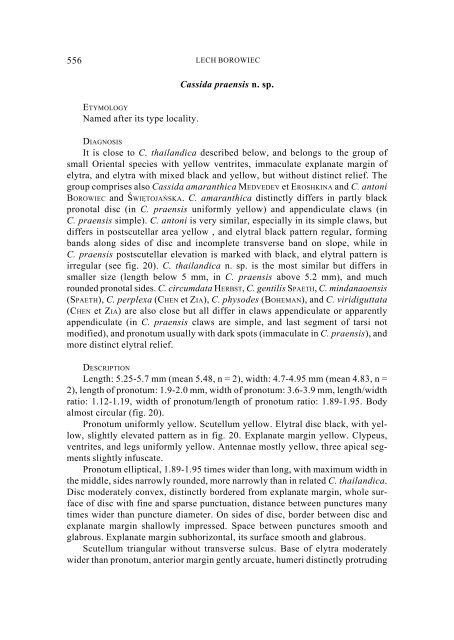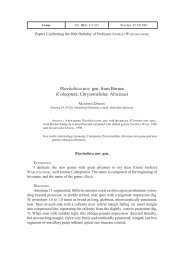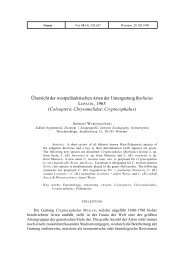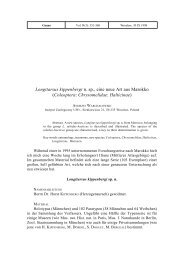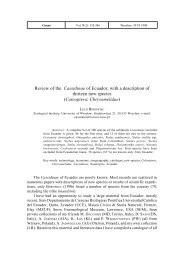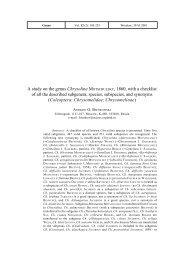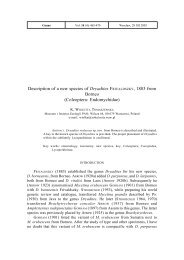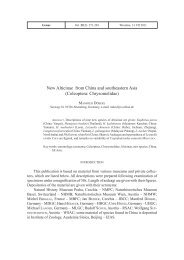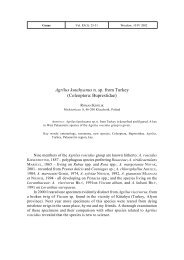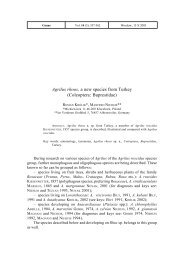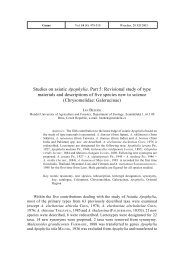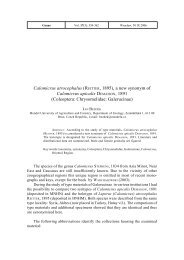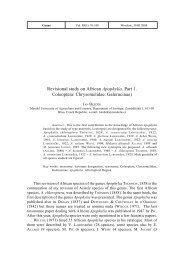New records of Asian and Australopapuan Cassidinae, with a ...
New records of Asian and Australopapuan Cassidinae, with a ...
New records of Asian and Australopapuan Cassidinae, with a ...
Create successful ePaper yourself
Turn your PDF publications into a flip-book with our unique Google optimized e-Paper software.
556<br />
ETYMOLOGY<br />
Named after its type locality.<br />
LECH BOROWIEC<br />
Cassida praensis n. sp.<br />
DIAGNOSIS<br />
It is close to C. thail<strong>and</strong>ica described below, <strong>and</strong> belongs to the group <strong>of</strong><br />
small Oriental species <strong>with</strong> yellow ventrites, immaculate explanate margin <strong>of</strong><br />
elytra, <strong>and</strong> elytra <strong>with</strong> mixed black <strong>and</strong> yellow, but <strong>with</strong>out distinct relief. The<br />
group comprises also Cassida amaranthica MEDVEDEV et EROSHKINA <strong>and</strong> C. antoni<br />
BOROWIEC <strong>and</strong> ŒWIÊTOJAÑSKA. C. amaranthica distinctly differs in partly black<br />
pronotal disc (in C. praensis uniformly yellow) <strong>and</strong> appendiculate claws (in<br />
C. praensis simple). C. antoni is very similar, especially in its simple claws, but<br />
differs in postscutellar area yellow , <strong>and</strong> elytral black pattern regular, forming<br />
b<strong>and</strong>s along sides <strong>of</strong> disc <strong>and</strong> incomplete transverse b<strong>and</strong> on slope, while in<br />
C. praensis postscutellar elevation is marked <strong>with</strong> black, <strong>and</strong> elytral pattern is<br />
irregular (see fig. 20). C. thail<strong>and</strong>ica n. sp. is the most similar but differs in<br />
smaller size (length below 5 mm, in C. praensis above 5.2 mm), <strong>and</strong> much<br />
rounded pronotal sides. C. circumdata HERBST, C. gentilis SPAETH, C. mindanaoensis<br />
(SPAETH), C. perplexa (CHEN et ZIA), C. physodes (BOHEMAN), <strong>and</strong> C. viridiguttata<br />
(CHEN et ZIA) are also close but all differ in claws appendiculate or apparently<br />
appendiculate (in C. praensis claws are simple, <strong>and</strong> last segment <strong>of</strong> tarsi not<br />
modified), <strong>and</strong> pronotum usually <strong>with</strong> dark spots (immaculate in C. praensis), <strong>and</strong><br />
more distinct elytral relief.<br />
DESCRIPTION<br />
Length: 5.25-5.7 mm (mean 5.48, n = 2), width: 4.7-4.95 mm (mean 4.83, n =<br />
2), length <strong>of</strong> pronotum: 1.9-2.0 mm, width <strong>of</strong> pronotum: 3.6-3.9 mm, length/width<br />
ratio: 1.12-1.19, width <strong>of</strong> pronotum/length <strong>of</strong> pronotum ratio: 1.89-1.95. Body<br />
almost circular (fig. 20).<br />
Pronotum uniformly yellow. Scutellum yellow. Elytral disc black, <strong>with</strong> yellow,<br />
slightly elevated pattern as in fig. 20. Explanate margin yellow. Clypeus,<br />
ventrites, <strong>and</strong> legs uniformly yellow. Antennae mostly yellow, three apical segments<br />
slightly infuscate.<br />
Pronotum elliptical, 1.89-1.95 times wider than long, <strong>with</strong> maximum width in<br />
the middle, sides narrowly rounded, more narrowly than in related C. thail<strong>and</strong>ica.<br />
Disc moderately convex, distinctly bordered from explanate margin, whole surface<br />
<strong>of</strong> disc <strong>with</strong> fine <strong>and</strong> sparse punctuation, distance between punctures many<br />
times wider than puncture diameter. On sides <strong>of</strong> disc, border between disc <strong>and</strong><br />
explanate margin shallowly impressed. Space between punctures smooth <strong>and</strong><br />
glabrous. Explanate margin subhorizontal, its surface smooth <strong>and</strong> glabrous.<br />
Scutellum triangular <strong>with</strong>out transverse sulcus. Base <strong>of</strong> elytra moderately<br />
wider than pronotum, anterior margin gently arcuate, humeri distinctly protruding


